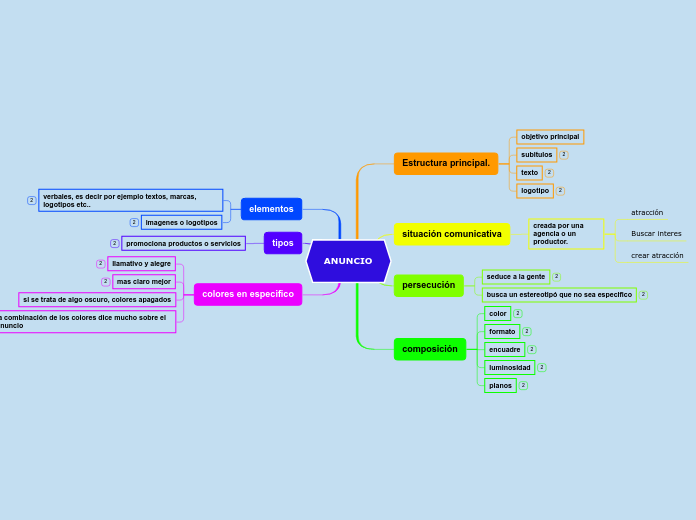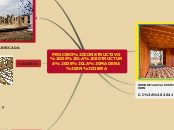ANUNCIO
The part of speech is a category to which a word is assigned according to its syntactic functions. In English the main parts of speech are noun, pronoun, adjective, determiner, verb, adverb, preposition, conjunction, and interjection.
colores en especifico
A conjunction is a word like 'if' 'but' or 'and' which is used to connect sentences or clauses together.
la combinación de los colores dice mucho sobre el anuncio
si se trata de algo oscuro, colores apagados
mas claro mejor
Subordinating conjunctions are conjunctions that are used at the beginning of subordinate clauses. Some examples of these conjunctions are: although, after, before, because, how, if, once, since, so that, until, unless, when etc.
Although it was raining, I went out.
llamativo y alegre
Coordinating conjunctions always connect phrases, words, and clauses. They are: for, and, nor, but, or, yet, so.
This stew is savory and delicious.
tipos
An adverb is used to describe a verb, but it can also describe an adjective or another adverb.
Adverbs normally help paint a fuller picture by describing how something happens.
promociona productos o servicios
Carefully, Slowly
elementos
A numeral is a word or phrase that describes a numerical quantity.
Some theories of grammar use the word 'numeral' to refer to cardinal numbers that act as a determiner to specify the quantity of a noun, for example the 'two' in 'two hats'.
imagenes o logotipos
One, two..
verbales, es decir por ejemplo textos, marcas, logotipos etc..
First, second..
composición
A pronoun is a word that can be used in place of a noun, typically after the noun itself has already been stated.
planos
Reciprocal pronouns are used for actions or feelings that are reciprocated. The reciprocal pronouns are each other and one another.
Each other, one another
luminosidad
A reflexive pronoun ends with ...self or ...selves and refers to another noun or pronoun in the sentence (usually the subject of the sentence). The reflexive pronouns are myself, yourself, herself, himself, itself, ourselves, yourselves, and themselves.
Itself, Himself
encuadre
Demonstrative pronouns are used to demonstrate (or indicate). This, that, these, and those are all demonstrative pronouns.
This, These
formato
Possessive pronouns are used to show possession. The possessive pronouns are mine, yours, his, hers, ours, and theirs.
His, Your
color
The personal pronouns are I, you, he, she, it, we, they. More often than not (but certainly not always), they replace nouns representing people.
He, They
persecución
An adjective is a word that's used to describe a specific noun and to provide more detail to the listener.
busca un estereotipó que no sea especifico
Superlative adjectives demonstrate a higher level of comparison between entities.
She is the prettiest princess.
seduce a la gente
Expresses a comparison between two entities or groups of entities in quality or degree.
He is taller than she is.
situación comunicativa
A noun is defined as a person, place, thing or idea. Proper nouns always begin with a capital letter. Common nouns, which are general words, such as 'cars,' are not capitalized.
creada por una agencia o un productor.
Compound nouns are words where two nouns have been stuck together to make a new noun. Compound nouns should be written as one word, without a hyphen.
crear atracción
Buscar interes
atracción
Estructura principal.
A verb is an action word or 'doing' word that signifies movement in some way.
logotipo
A participle is a verb form that can be used as an adjective or to create a verb tense. There are two types of participles: Present participle (ending -ing) and Past participle (usually ending -ed, -d, -t, -en, or -n).
The winning athlete gets a trophy.
texto
A modal is a type of auxiliary (helping) verb that is used to express: ability, possibility, permission or obligation. The main modal verbs in the English language are: can, could, may, might, must, shall, should, will, would.
I might go to the park if I get my homework done.
subitulos
A linking verb connects the subject with a word that gives information about the subject, such as a condition or relationship.
Create sentences
You look exhausted after studying all night.
objetivo principal
A verb with its own meaning: a verb that is not an auxiliary verb.









